In the beginning of many chapters of the Quran, we find the following sets of mysterious letters:
- A.L.M.
- A.L.M.S.
- A.L.R.
- A.L.M.R.
- K.H.Y.`A.S.
- T.H.
- T.S.
- T.S.M.
- Y.S.
- S (Saad)
- `A.S.Q.
- H.M.
- Q
- N
For 14 centuries, scholars, linguists, and scientists were not able to decode their meaning. We can divide the scholars of these letters into three groups:
- The first group of scholars are the ones who gave up trying to understand them and claimed that these letters are a secret forever, and only God knows their meaning. However, this contradicts the statements in the Quran which tell us that the verses, including these groups of letters, are clear (26:2, 28:2, 43:2, 44:2, 12:1, 15:1, 27:1), which means that we can know their meaning. These letter are also called a revelation (40:2, 41:2, 45:2, 46:2), which means that they were not meant to be a secret. A revelation is something which stops being a secret. Also, the Quran tells us that all its verses, including these letters, are verses with one meaning or multiple meanings (3:7), but it never mentions verses which have no meaning. So, clearly, this group of scholars is wrong.
- The second group of scholars includes those who have attempted to give us the meaning, but they always got it wrong. They invented ridiculous ideas, like claiming that these the names of God, but this cannot be true because the Quran calls these letters “proofs of God” (10:1, 12:1, 13:1, 15:1, 26:2, 28:2, 31:2, 38:1). Proofs of God are not names of God. For example, the sky is a proof of God, but it is not a name of God. Creatures of God are not God. So, they unknowingly committed a blasphemy by describing signs of God as God, and also they went against God, who prohibits us to say anything about Him which we do not know for sure (7:33, 2:169).
- The third group of scholars includes those who gave correct comments about these letters, but it had nothing to do with their meaning. For example, they said that these letters are important for chanting or rhythmic purposes during recitation, which is true, but this has nothing to do with their meaning. The whole Quran is a rhythmical book anyway – it sounds like poetry with rhyme in Arabic – and yet the other words in the Quran also have meaning. Another example of correct comments about these letters is that they are important for keeping the Quran preserved through a mathematical code, and that their frequencies of occurrence prove statistically that the Quran is a revelation from God. This is a great discovery, but it has nothing to do with their meaning. Because of that discovery, we now understand the statistical significance of these letters, and their role in the structure of the Quran, but it still does not tell us their meaning. The question still remains. What does A.L.M mean? What does H.M. mean? What does T.S. mean? We know now how important they are, but what do they mean? To find out what they mean, Alban Fejza, gave up on any ideas, including his own ideas, and decided to do the research systematically, which means that he simply listed everything that the Quran says about these letters, without trying to make sense of it in the beginning. So, he went through the whole Quran, and listed all the possible ways in which the Quran describes these letters.
The Quran calls these letters:
- “Scripture” (2:2, 7:2, 11:1, 14:1, 32:2)
- “Revelation” (40:2, 41:2, 45:2, 46:2)
- “Proofs, Signs, Symbols” (10:1, 12:1, 13:1, 15:1, 26:2, 28:2, 31:2, 38:1)
- “Letters” (10:1, 12:1, 13:1, 15:1, 26:2, 27:1, 28:2, 31:2, 68:1)
- “Verses” (10:1, 12:1, 13:1, 15:1, 26:2, 27:1, 28:2, 31:2)
- “Recitation in Arabic” (12:2, 15:1)
- “Removal of doubt” (2:2)
- “Seven Pairs” (15:87)
And we already knew this, and it makes sense that the Quran describes them like that, but the Quran calls these letters 11 more things, and these are the deeper and more interesting descriptions. The Quran also calls these letters:
- “Decree” (2:2, 7:2, 11:1, 14:1, 32:2)
- “Record” (2:2, 7:2, 11:1, 14:1, 32:2)
- “Guidance” (2:2, 27:2, 31:3)
- “Remembrance” (38:1, 19:2, 7:2)
- “Clear Quran” (26:2, 28:2, 43:2, 44:2, 12:1, 15:1, 27:1)
- “Wisdom” (10:1, 11:1, 31:2)
- “Truth” (13:1)
- “Mercy for good people” (31:3, 19:2)
- “Good news for believers” (27:2)
- “A test (trial)” (29:2)
- “Warning” (11:2)
So, how can these letters be a warning, if we don’t understand what they mean? How can they be guidance, if we don’t understand what they mean? How can they be wisdom, if we don’t understand what they mean? How can they be remembrance? Remembrance of what? How can they be a decree? Decree about what? How can they be clear, unless we understand their meaning? And all of this make sense now, once Alban Fejza explained their meaning to us. We can see how they are a decree, record, guidance, remembrance, clear, wisdom, truth, good news, a test, mercy, and warning, all at the same time. So, now let’s delve into their meaning:
To know their meaning, we have to look at where these letters came from. According to linguists and historians, the letters of the Arabic alphabet came from the proto-Arabic versions which originated from the Phoenician Alphabet or the North Semitic alphabet, or the Proto-Sinaitic Alphabet, which originated in Sinai, otherwise known as the Early Alphabetic. So, the Phoenician Alphabet is the first alphabet in the world, from which all the alphabets of the people of the scripture come from. This alphabet originated from pictograms of specific words. For example, “Alif”, the letter “A” came from a simplified symbolic drawing of an “Ox” in that ancient proto-Arabic or proto-Semitic or Phoenician language. This happened at about the time of Abraham. However, the Arabs did not preserve this alphabet very well, since they did not use it much. Scientific writing and written literature were almost inexistent during that time in ancient Arabia, so these letters could easily change shape, and no other person would complain. Also the ancient Israelis changed these letters significantly, because of their exile in Babylon, and so on. However, the ancient Greeks who valued scientific writing and literature, borrowed the letters from the Phoenicians and they kept them almost intact until today because they used them constantly in their philosophy, science, and literature, and even latter in their Orthodox Church writings. So, it was not practical for ancient Greeks to significantly change the shapes of these letters, because they were being constantly used by many of them simultaneously, and any change by one person would be criticized by the other person who also used those letters independently. So, in the tables below you can see the letters in their Greek form, their Phoenician form, and the Arabic form:
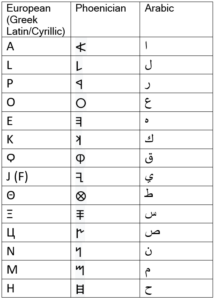
As you can see, out of the 14 letter shapes of the original alphabet, 13 of them have been basically preserved in Greek or Cyrillic or Latin, and only the direction has changed from left to right, because in the ancient times the direction of writing was not determined. People would write both ways, from right to left and from left to right. They were equally correct, and depending in which direction they wrote, they would flip the letters in that direction, and the left to right direction eventually became more dominant among the Europeans. Even in English, most of these shapes have been preserved, but in Arabic, their shapes have changed so much, they are not recognizable anymore. Of course, the pronunciation of these letters is correct in Arabic (like Alif, Laam, Meem, etc.), because Arabs had a great oral tradition, which is why God revealed them to them like sounds. These letters were revealed to Muhammad like sounds, correctly in the Arabic tongue. This is why the Quran says that it was revealed in Arabic tongue (26:195, 46:12), but it never says that it was revealed in Arabic writing. Muhammad did not see the letters as visions. He heard them from Gabriel as sounds (7:204), and then people wrote them in whatever alphabet they had available, which happened to be their distorted alphabet, which is why the Quran calls the Arabs and Muhammad “illiterate people” (62:2, 7:157), because they did not have the original writing system available among them. So again, God did not show these letters to Muhammad in a vision, because Muhammad would not recognize them. Instead Gabriel spoke them to him (2:97). But, when God showed the revelation to Moses, He gave it to him in writing (7:145), because at that time the letters were still correct among the Children of Israel, looking similar to the Phoenician and Greek letters. Phoenician alphabet went extinct, and the closest existing alphabet to it is the Greek alphabet, from which all the European alphabets descended. So, when it comes to writing these letters, and the shapes of these letters, among the existing languages, the European letters are the most correct ones, including the English letters for the most part. This is good news, because we can explain the meanings of these letters using mostly shapes of English letters, since this article is in English. So, it is not a coincidence that God saved the explanation of the meanings of these letters for a time when the English letters are the dominant letters of the world and the internet. And it is not a coincidence that He did it through Alban Fejza, a person of both European and Muslim descent. Alban Fejza happened to be at the center of this issue, just like the Arabs were at the center of correct speaking when the Quran was revealed, and just like the ancient Israelis were at the center of correct writing when the original Torah was revealed.
So, now let’s explain the meanings of all the letters (Quranic Initials) as they were in their original form in ancient times:
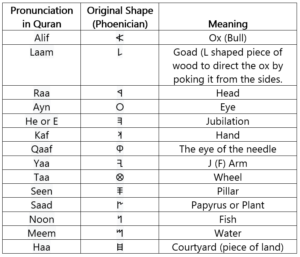
So, now we have the original symbols of these letters. However, they are not in appropriate size relative to each other. For example, an eye can not be as big as the head, and the eye of the needle can not be as big as the head of the ox. So, now, let’s replace these same symbols with more realistic representations of them.
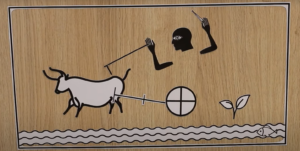
So, in the picture above which includes all those Quranic Initials in their ancient form, we can see an Ox, a goad to drive the ox (A), a head (R), an eye (O), jubilation (raised hands representing happiness) (E), a hand (K), a needle (Q), an arm (Y), a wheel (T), a pillar (S), a plant (Saad), water (M), fish (N), and the courtyard (H). You can probably see the connection already since they fit nicely with one another in the picture. So, we can see an owner with a piece of land driving an ox, and a few other things which he uses around him. But what does this mean? This is a very deep riddle. After a lot of thinking, trials, and mistakes, God guided Alban Fejza to the correct solution of the riddle.
This whole picture represents the whole earth, all of our civilization. The courtyard represents the Environment. The head represents the government; the eye represents the Media. If it is the eye of the ox, it represents us looking at the government, which is classical media, but if it is the eye of the human, it represents the government looking at us, which is social media. The arm is the Public Sector. The hand is Social Welfare which is included in the Public Sector, just like the hand is included in the arm. Raised happy hands must represent the Healthcare System. The goad is the technology. Technology drives the economy, so the ox must be the Economy. Besides driving the ox forward, the goad can also be used to turn the ox left and right, in which case, the goad is politics, turning the economy left and right. The ox drinks water. The Economy uses Energy. So, water must be the Energy Sector. The plant, if it grows in land, in the environment, it means agriculture, but most linguists consider it a papyrus plant, which grows in water, and is used to produce paper. In that case, it would be Education. The fish lives in water. We concluded that water is the Energy. So what lives inside the energy? Internet. So, the fish is the Internet. What about the needle? The human uses the needle for his own clothes, using the wool from the ox. So, if the ox is the economy, the wool must be the outside beautiful parts of the economy – the arts. So, what does the government do with the arts? It takes them and uses them for propaganda. So, the needle must be the tool which shapes the propaganda, which is information. So, the needle is information. Or maybe the needle is only used when you need to sew the torn clothes, only when propaganda fails, in which case governments use security, as a means to protect themselves? The wheel is Transportation, obviously. The pillar is Infrastructure, any kind of infrastructure. In the picture, it is placed beside the wheel, which means road infrastructure, but we can place it in any other places in this picture, and it would represent other types of infrastructure. The deciphered linguistic meanings of all the Quranic Initials are shown in the picture below:
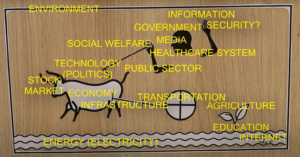
So, now the meaning of each symbol has been deciphered. For a couple of those meanings, we have to be careful due to their possibility for a slightly different interpretation. This is because we used linguistic and archeological sciences as additional sources to decipher these meanings, and these sciences (linguistics and archeology) are approximate sciences, and not always 100% exact. For example, the letter Alif stands for the Ox, which represents the Economy, but some historians say that Alif symbolizes only the head of the ox, (not the whole ox), which would represent only the Stock Market, the head of the Economy, not the whole Economy. To keep it simple, we are giving only one interpretation here.
Someone might ask, “Why did not God just mention these concepts directly? Why did He use the symbol of an ox, instead of simply using the word “Economy”? Well, God refuses to use human-made terminology. The word “Economy” is a made up word. It does not mean anything concrete. There is not even an agreement amongst Economists what the best definition of Economy is. Of course, God recognizes the components of the economy, but He does not need to give a name to the whole group of things, like humans did. We, humans, invented a vague name for that. As far as God is concerned, we are just a group of people selling things to each other in exchange for something else, and we call those things “products” which we produce through what we call “a management system”, which according to God is simply “wise behavior”. To God, there is no such thing as “Economic knowledge”. It’s just wisdom. So, all these concepts are human made concepts which are vague and only approximately describe a group of other components, while only those real (truly existing) components are mentioned by God. Only things which are 100% defined are mentioned by God. According to God, there is no such thing as “cuisine”, for example. It’s just food and eating, and ways of cooking. Not even “cooking”, just “heating”, “burning”, and “preparing”. There is no such things as “fashion”. It’s just short clothes, and long clothes, and wide clothes and tight clothes, and differently shaped clothes, and different combinations of colors, and these things are real, but fashion only exists in our minds. It’s not completely real. It’s a social construct. A social construct is something which appears to exist only because humans have agreed that it exists. It’s hard for humans to realize that it does not really exist, because humans have heard that word from early childhood, but it really does not exist. It’s just a word which humans invented, a symbol to represent a combination of things and concepts arranged in an approximate way in human minds. So, when we use social constructs nothing completely true can ever be expressed, but at the same time nothing completely false can ever be expressed, which is explained in another video, but the main idea here is that at the moment when we use social constructs, we are always at least partly wrong. So, God who is perfect, refuses to be partly wrong. He knows those words, He knows we use them, but He does not use them, because they are invented concepts which exist only in human minds, cultural concepts. They reflect a common language between believers and disbelievers for peaceful coexistence and survival, but God never approved or disapproved those concepts. He only agreed with Adam what language we should use, and to give names to real things which He created, and which exist, but everything else is just something we made up. It reflects our imperfections, our allowable imperfections, but not anything which has any basis in fundamental reality. Where is fashion, for example? Can you touch it? Where is the economy? What color does it have? It does not really exist. God knew that these concepts would emerge as a result of civilization, but He refused to mention them, and yet He found a way to let us know that it was His plan for those concepts to emerge. This is part of the reason, why the Quran is the last book revealed, because there is nothing more true which you can mention, no matter how many more words we invent. When we use the modern created concepts, we can only express partial truths or partial lies. God does not speak in partial truths. So, what He did is that He informed us about these concepts using symbols, and then He let Alban Fejza decode them, knowing that Alban Fejza is imperfect enough to use concepts which are partially correct in his vocabulary. So, Alban Fejza (who discovered the meanings of Quranic Initials) served as a bridge between the complete truths and the partial truths of the modern world.
The other reason why God used these symbols in the Quran instead of directly mentioning the modern areas of civilization, is because these symbols are more than just that. They are also numbers. In the ancient times, people used the symbols of the alphabet to write the numbers, before written numbers existed. So, each letter of the alphabet also represented a number. For example, A is 1, L is 30, M is 40, and you can see in the clarifying video titled “The End of the World” that these numbers represent the number of lunar years until a certain event in the future, which is why these letters are described in the Quran as revelations. A revelation is news from the future. These letters (Quranic Initials) are also called warnings, so through these letters God is warning us about certain events in the future, and you can see above what areas of civilization these letters represent. So, they must be warnings about those specific areas of civilization, which will happen after a given number of lunar years. So, the symbols (the Quranic Initials) tell us two things at once:
- The types of global crises, and
- The number of lunar years until they happen.
But, from which year should we start the counting? Well, because Alban Fejza discovered their meaning, that means that it was meant to be seen from Alban Fejza’s perspective, from the time when he was given these letters. He was given these letters in 2005, which is the Hijri or lunar year 1426, and he explains in detail how this happened in his video titled, “My Journey to Truth and Enlightenment”, but to keep it short here, let’s just take that year, the Hijri year 1426, as the starting point from where we measure the Quranic future predictions.
So, the table below lists the Quranic Initials, their corresponding numerical value, their corresponding Hijri Year, which is then converted to its corresponding Gregorian Year to show when the crisis will happen, and then it also lists the area of the crisis which will happen in that year:
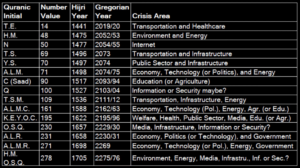
As, you can see the table above suggests that there will be a global crisis in the area of Transportation and Healthcare in the years 2019 and 2020. As you know, this already happened. It was the COVID-19 Pandemic. It started as a Healthcare Crisis, and then the Governments tried to prevent the Healthcare System from overloading, and imposed a prohibition of travel and transportation, including the flights and public transportation, so it became both a Healthcare and a Human Transportation Crisis. So, the first event already came true. The upcoming events after it as seen in the table will be an Environment and Energy crisis in 2052/53; An Internet crisis in 2054/55. A crisis in Transportation and Infrastructure in 2073; A crisis in Public Sector and Infrastructure in 2074; A crisis in Economy, Technology (or Politics), and Energy in 2074/75; A crisis in Education or Agriculture in 2093/94; An information crisis in 2103/04 – this crisis might not be easy to see, just like it is not easy to see the eye of the needle. Then, a crisis in Transportation, Infrastructure, and Energy in 2111/12; A crisis in Economy, Technology or Politics, Energy, and Education or Agriculture in 2162/63. A crisis in Social Welfare, Healthcare, Public Sector, Media, and Agriculture or Education in 2195/96. A crisis in Media, Infrastructure, and Information in 2229/30; A crisis in Economy, Politics (or Technology), and Government in 2230/31; A crisis in Economy, Technology (or Politics), Energy, and Government in 2269. It is probably worth mentioning that some of these crises are in years joined one after the other, for example in 2073, 2074, and 2075, and this might very well be one large crisis across three years gradually spreading from one area in one year into another area in the next years. The other big crisis seems to start in 2229/30, and spread to other areas in 2230/31. So, we can actually think of these fourteen crises as eleven crises – three big ones, and eight smaller ones. Also, at the end of the table is listed a bonus crisis. There is a special case, only one case of initials, where two separate Quranic initials occur one after another in the same Sura, in Sura 42. We find Ha Meem in the first verse, and then Ain Seen Qaaf in the second verse. We already listed them in the table separately, but since they are also in the same Sura together they give us a bigger year together. If we consider them together, it seems to suggest that in the year 2275 or 2276 a destruction in the Environment, Energy, Media, Infrastructure, and Internet, and this seems to suggest a war which would damage these areas, and because it is just 4 years before the End of the World, it must be the war between the Mahdi and Antichrist. And by the way, as you can see, out of all the groups of initials, none of their values goes beyond the year 2280, which is when the world will end, which Alban Fejza explains in the other clarifying video titled “The End of the World”. But this is additional confirmation that this table is correct. If the table was not correct, there is a high likelihood that at least one of the Quranic Initials would be large enough to correspond to a year after the end of the world, which would be a contradiction, but all of them fit nicely within the timeframe before the End of the World, with the last one happening just a few years before the End of the World.
Now, let us remind ourselves again how the Quran describes these letters, and we can see how those descriptions make sense now:
- So, the Quran calls these letters “Decree” (2:2, 7:2, 11:1, 14:1, 32:2), and yes they are what God has decreed for the modern civilization.
- They are called “Record” (2:2, 7:2, 11:1, 14:1, 32:2), and yes they are a future record what will happen to the world.
- They are called “Clear Quran” (26:2, 28:2, 43:2, 44:2, 12:1, 15:1, 27:1), yes, now that we understand them, they are clear finally.
- They are called “Wisdom” (10:1, 11:1, 31:2), because from them we also can understand how different areas of modern civilization are interconnected, just like the pieces in that puzzle with the farmer, and the ox, and the goad and so on are interconnected with each other. There is so much more wisdom to be learned from that example only, because some of those symbols can be recombined in quite a few other ways to help us understand how the world functions.
- They are called “A test (trial)” (29:2), because modern people will be tested through those crises which will happen.
- They are called a “Warning” (11:2), because the disbelievers are warned about the sufferings which they will incur.
- They are called “Truth” (13:1), because it is really what will happen.
- They are called “Guidance” (2:2, 27:2, 31:3), because the believers will be guided and prepared how to avoid the damages from those crises.
- They are called “Good news for believers” (27:2), because the believers who believe this video have the opportunity to use this information to their advantage, by investing appropriately or withdrawing the investments before those crises happen, and thus use the opportunity to avoid loses, get rich, give charity, and ultimately win.
By: Alban Fejza, the Clarifying Messenger